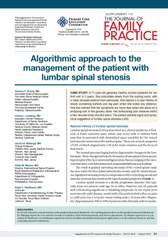Lumbar spinal stenosis (LSS) is a clinical syndrome of buttock or lower extremity pain, which may occur with or without back pain that is associated with diminished space available for the neural and vascular elements in the lumbar spine. There are several categories of LSS, of which degenerative LSS is the most common and the focus of this supplement. The normal process of aging leads to degenerative changes in the lumbar spine. The result is gradual narrowing (stenosis) of the central spinal canal, the area under the facet joints (subarticular recess), and the neural foramina. Significant stenosis produces compression of the underlying neural and vascular elements that results in the typical painful symptoms.
This supplement provides recommendations from a consensus panel of experts on how to treat and manage LSS, including assessment and diagnosis and surgical and non-surgical treatment plans. The supplement also includes a detailed LSS management algorithm for use by the family physician.


